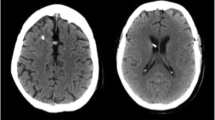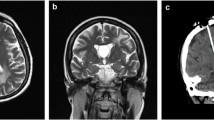Abstract
Background
For intraventricular chemotherapy (IVC) as part of many oncological treatment protocols, Ommaya reservoir is enabling repeated access to the cerebro-spinal fluid (CSF). The correct placement of the catheter in the ventricle is essential for correct application of drugs, which is enabled by sophisticated techniques such as neuronavigation.
Objective
In a bi-center retrospective study, we reviewed our experience using a smartphone-assisted ventricle catheter guide as simple solution for correct Ommaya reservoir placement.
Methods
Sixty Ommaya reservoirs have been placed in 60 patients between 2011 and 2017 with the smartphone-assisted ventricular catheter guidance technique. Patient characteristics, preoperative frontal and occipital horn ratio (FOHR), postoperative catheter position, and complications were assessed.
Results
The majority of our patients (71.6%) have got narrow or slit-like ventricles (FOHR ≤ 0.4). All Ommaya reservoirs were placed successfully. Fifty-eight ventricular catheters (97%) were inserted at the first and 2 (3%) at the second attempt using the same technique. No immediate perioperative complications were observed. All catheters (100%) could be used for IVC. Postoperative imaging was available in 52 patients. Thirty-two (61.5%) of ventricular catheters were rated as grade I, 20 (38.5%) as grade II, and none (0%) as grade III. Four patients (6.7%) showed postoperative complications during a median follow-up of 8.5 months (hydrocephalus, n = 1; infection, n = 1; parenchymal cyst around catheter, n = 1; shunt revision, n = 1).
Conclusions
The smartphone-assisted guide offers decent accuracy of ventricle catheter placement with ease and simplicity for a small surgical intervention. We propose this technique as routine tool for Ommaya reservoir placement independent of lateral ventricular size to decrease the rate of ventricle catheter malposition as reasonable alternative to a neuronavigation system.


Similar content being viewed by others
References
Bleyer WA, Poplack DG, Simon RM (1978) “Concentration x time” methotrexate via a subcutaneous reservoir: a less toxic regimen for intraventricular chemotherapy of central nervous system neoplasms. Blood 51(5):835–842
Sandberg DI, Bilsky MH, Souweidane MM, Bzdil J, Gutin PH (2000) Ommaya reservoirs for the treatment of leptomeningeal metastases. Neurosurgery 47:49–54 discussion 54-45
Shapiro WR, Young DF, Mehta BM (1975) Methotrexate: distribution in cerebrospinal fluid after intravenous, ventricular and lumbar injections. N Engl J Med 293(4):161–166. https://doi.org/10.1056/NEJM197507242930402
Yoshida S, Morii K (2005) Intrathecal chemotherapy for patients with meningeal carcinomatosis. Surg Neurol 63(1):52–55; discussion 55. https://doi.org/10.1016/j.surneu.2004.06.011
Balis FM, Blaney SM, McCully CL, Bacher JD, Murphy RF, Poplack DG (2000) Methotrexate distribution within the subarachnoid space after intraventricular and intravenous administration. Cancer Chemother Pharmacol 45(3):259–264. https://doi.org/10.1007/s002800050038
Morgenstern PF, Connors S, Reiner AS, Greenfield JP (2016) Image guidance for placement of Ommaya reservoirs: comparison of fluoroscopy and frameless stereotactic navigation in 145 patients. World Neurosurg 93:154–158. https://doi.org/10.1016/j.wneu.2016.04.090
Ozerov SS, Mel’nikov AV, Ibragimova DI, Tereshchenko GV, Rachkov VE (2014) Placement of the Ommaya reservoir in narrow and slit-like ventricles using a neuronavigation system. Author’s own experience and literature review. Zh Vopr Neirokhir Im N N Burdenko 78(3):38–43
Wang A, Tenner MS, Tobias ME, Mohan A, Kim D, Tandon A (2016) A novel approach using electromagnetic neuronavigation and a flexible neuroendoscope for placement of Ommaya reservoirs. World Neurosurg 96:195–201. https://doi.org/10.1016/j.wneu.2016.08.127
Weiner GM, Chivukula S, Chen CJ, Ding D, Engh JA, Amankulor N (2015) Ommaya reservoir with ventricular catheter placement for chemotherapy with frameless and pinless electromagnetic surgical neuronavigation. Clin Neurol Neurosurg 130:61–66. https://doi.org/10.1016/j.clineuro.2014.12.018
LW X, Sussman ES, Li G (2016) Frameless, electromagnetic image-guided ventriculostomy for ventriculoperitoneal shunt and Ommaya reservoir placement. Clin Neurol Neurosurg 147:46–52
Yim B, Reid Gooch M, Dalfino JC, Adamo MA, Kenning TJ (2016) Optimizing ventriculoperitoneal shunt placement in the treatment of idiopathic intracranial hypertension: an analysis of neuroendoscopy, frameless stereotaxy, and intraoperative CT. Neurosurg Focus 40(3):E12. https://doi.org/10.3171/2015.12.FOCUS15583
Thomale UW (2015) Intracranial ventricular catheter placement with a smartphone assisted instrument. Methods Mol Biol 1256:405–417. https://doi.org/10.1007/978-1-4939-2172-0_27
Thomale UW, Knitter T, Schaumann A, Ahmadi SA, Ziegler P, Schulz M, Miethke C (2013) Smartphone-assisted guide for the placement of ventricular catheters. Childs Nerv Syst 29(1):131–139. https://doi.org/10.1007/s00381-012-1943-1
Thomale U-W, Schaumann A, Stockhammer F, Giese H, Schuster D, Kästner S, Ahmadi AS, Polemikos M, Bock H-C, Gölz L, Lemcke J, Hermann E, Schuhmann MU, Beez T, Fritsch M, Orakcioglu B, Vajkoczy P, Rohde V, Bohner G (2017) GAVCA study: randomized, multicenter trial to evaluate the quality of ventricular catheter placement with a mobile health assisted guidance Technique. Neurosurgery. https://doi.org/10.1093/neuros/nyx420
Kulkarni AV, Drake JM, Armstrong DC, Dirks PB (1999) Measurement of ventricular size: reliability of the frontal and occipital horn ratio compared to subjective assessment. Pediatr Neurosurg 31(2):65–70. https://doi.org/10.1159/000028836
Huyette DR, Turnbow BJ, Kaufman C, Vaslow DF, Whiting BB, MY O (2008) Accuracy of the freehand pass technique for ventriculostomy catheter placement: retrospective assessment using computed tomography scans. J Neurosurg 108(1):88–91. https://doi.org/10.3171/JNS/2008/108/01/0088
Saladino A, White JB, Wijdicks EF, Lanzino G (2009) Malplacement of ventricular catheters by neurosurgeons: a single institution experience. Neurocrit Care 10(2):248–252. https://doi.org/10.1007/s12028-008-9154-z
Wilson TJ, Stetler WR Jr, Al-Holou WN, Sullivan SE (2013) Comparison of the accuracy of ventricular catheter placement using freehand placement, ultrasonic guidance, and stereotactic neuronavigation. J Neurosurg 119(1):66–70. https://doi.org/10.3171/2012.11.JNS111384
Hayhurst C, Beems T, Jenkinson MD, Byrne P, Clark S, Kandasamy J, Goodden J, Nandoe Tewarie RD, Mallucci CL (2010) Effect of electromagnetic-navigated shunt placement on failure rates: a prospective multicenter study. J Neurosurg 113(6):1273–1278. https://doi.org/10.3171/2010.3.JNS091237
Kennedy BC, Brown LT, Komotar RJ, Mckhann GM 2nd (2016) Stereotactic catheter placement for Ommaya reservoirs. J Clin Neurosci 27:44–47. https://doi.org/10.1016/j.jocn.2015.11.005
Whitehead WE, Riva-Cambrin J, Wellons JC 3rd, Kulkarni AV, Browd S, Limbrick D, Rozzelle C, Tamber MS, Simon TD, Shannon CN, Holubkov R, Oakes WJ, Luerssen TG, Walker ML, Drake JM, Kestle JR, for the Hydrocephalus Clinical Research N (2014) Factors associated with ventricular catheter movement and inaccurate catheter location: post hoc analysis of the hydrocephalus clinical research network ultrasound-guided shunt placement study. J Neurosurg Pediatr 14(2):173–178. https://doi.org/10.3171/2014.5.PEDS13481
Whitehead WE, Riva-Cambrin J, Wellons JC 3rd, Kulkarni AV, Holubkov R, Illner A, Oakes WJ, Luerssen TG, Walker ML, Drake JM, Kestle JR, Hydrocephalus Clinical Research N (2013) No significant improvement in the rate of accurate ventricular catheter location using ultrasound-guided CSF shunt insertion: a prospective, controlled study by the Hydrocephalus Clinical Research Network. J Neurosurg Pediatr 12(6):565–574. https://doi.org/10.3171/2013.9.PEDS1346
Nesvick CL, Khan NR, Mehta GU, Klimo P Jr (2015) Image guidance in ventricular cerebrospinal fluid shunt catheter placement: a systematic review and meta-analysis. Neurosurgery 77(3):321–331; discussion 331. https://doi.org/10.1227/NEU.0000000000000849
Ozerov SS, Samarin AE, Mel'nikov AV, Kumirova EV (2017) Placement of a ventricular catheter into narrow lateral ventricles. Popular navigation. Zh Vopr Neirokhir Im N N Burdenko 81(2):72–76. https://doi.org/10.17116/neiro201781272-76
Schaumann A, Thomale UW (2013) Guided application of ventricular catheters (GAVCA)—multicentre study to compare the ventricular catheter position after use of a catheter guide versus freehand application: study protocol for a randomised trail. Trials 14(1):428. https://doi.org/10.1186/1745-6215-14-428
Thomale UW, Hosch H, Koch A, Schulz M, Stoltenburg G, Haberl EJ, Sprung C (2010) Perforation holes in ventricular catheters—is less more? Childs Nerv Syst 26(6):781–789. https://doi.org/10.1007/s00381-009-1055-8
Peyrl A, Chocholous M, Azizi AA, Czech T, Dorfer C, Mitteregger D, Gojo J, Minichmayr E, Slavc I (2014) Safety of Ommaya reservoirs in children with brain tumors: a 20-year experience with 5472 intraventricular drug administrations in 98 patients. J Neuro-Oncol 120(1):139–145. https://doi.org/10.1007/s11060-014-1531-1
Author information
Authors and Affiliations
Corresponding author
Ethics declarations
Conflict of interest
UWT holds a patent on the guiding instrument. UWT and AS received lecture honorarium from Miethke Aesculap Comp. in the past. All other authors have no conflict of interest to declare.
Rights and permissions
About this article
Cite this article
Ozerov, S., Thomale, U.W., Schulz, M. et al. The use of a smartphone-assisted ventricle catheter guide for Ommaya reservoir placement—experience of a retrospective bi-center study. Childs Nerv Syst 34, 853–859 (2018). https://doi.org/10.1007/s00381-017-3713-6
Received:
Accepted:
Published:
Issue Date:
DOI: https://doi.org/10.1007/s00381-017-3713-6




